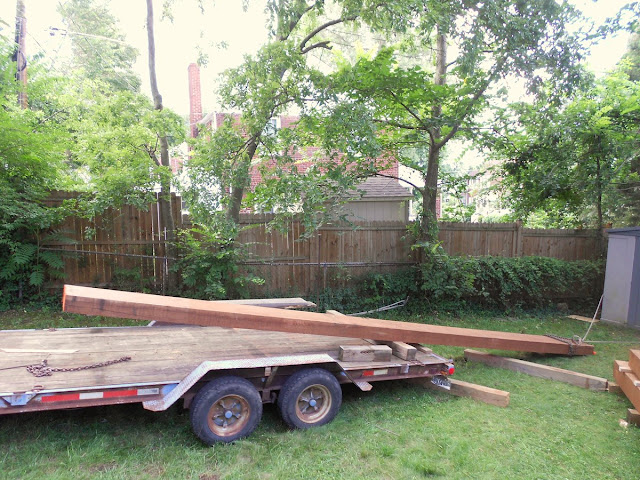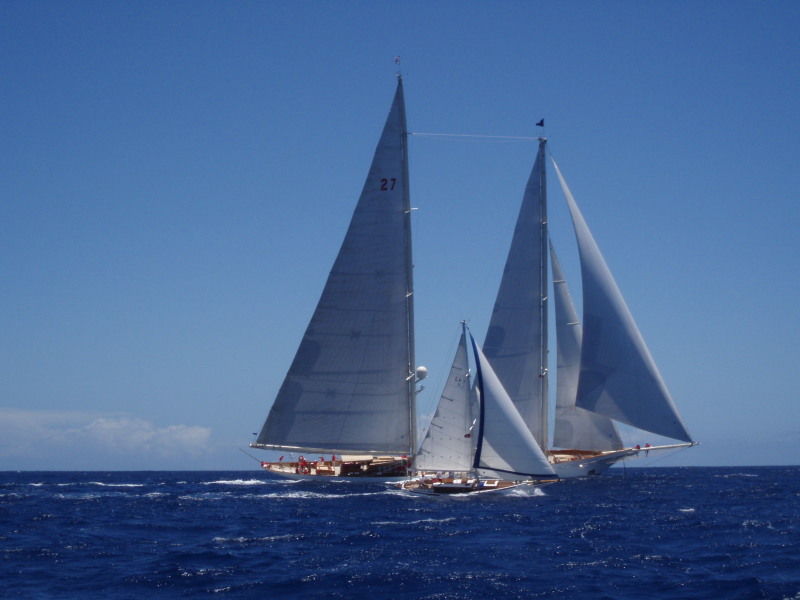So I've decided to create a blog. This is relevant because not long ago, I made the similar but rather more ambitious decision to build a boat. That project, the course of which this blog will document, is going to take a long time to finish, and I hope that by committing myself to some semblance of regular updates here, I can maintain the self-discipline necessary to see it through to completion. Once that happens - a day which seems vanishingly distant to me right now- maybe this will then transform into a cruising blog. For now and the foreseeable future, though, it's going to be a blog about boat construction, and an explanation of its title is in order. Before that, however, I ought to briefly introduce the boat that I'm attempting to build.
The thirty-foot falmouth cutter designed by Lyle Hess is a rugged offshore sailboat based on the ones that were
used to deliver harbor pilots to waiting merchant vessels off the west coast of England during the age of sail. They needed to be able to operate year-round and in all weather conditions, and to lead the big ships into the harbor safely every time. Inspired by this design, Hess adapted it into a robust, heavy displacement ocean cruising yacht with ample beam and low freeboard. When famous circumnavigators Lin and Larry Pardey returned to California in search of a bigger boat, Hess knew just what hull to draw for them. Since then, the Pardeys have
taken their Falmouth 30 across the world and around Cape Horn. Rolland Trowbridge
sailed the Northwest Passage in one, along with his family of four. Randy Hanford, a shipwright from Baltimore, sailed his to French Polynesia. If ever there was a gorgeous boat fit to do some serious exploring, this is it.
Lin and Larry Pardey's Taleisin, class leader. (Image Credit: Nauticalmind.com)
Picking a name for something as significant and enduring as a yacht can be a long and time-consuming process, with names coming into and falling out of favor as their meanings and connotations are deliberated ad infinitum. As a space scientist and amateur astronomer, I wanted a name that brought to mind a celestial connection, but also one that simultaneously held a connection to ships and the sea. And of course, it had to sound pretty.
Happily, I had just the one already picked out. I'd fallen in love with the name ever since middle school, when I'd first read about it as the constellation in which the homeworld of the Overlord race was located in Arthur C. Clarke's classic 1953 science fiction novel
Childhood's End. Depicting the keel of Jason's ship
Argo, the
constellation Carina stretches across the southern hemisphere's skies between -50º and -75º declination. It is dominated by Canopus, the second-brightest star in the night sky, and by Eta Carinae, a cataclysmic variable four million times brighter than the sun, whose 1843 outburst briefly made it the brightest star of all. Sailing ships, awesome space stuff, and absolutely beautiful-sounding, Carina had it all. There was only one problem: there's another one out there.
Once I decided, after much deliberation, that this was the boat I wanted to spend tens of thousands of dollars and several years of my life realizing, I enthusiastically purchased the plans from Lyle's daughter. In between laying down the lines and sourcing materials for the project, I spent my evenings googling for anyone who'd built one before, so that I might find inspiration in their own interpretations of the Falmouth 30.
And then I saw it.
Jim Donovan was the same age as myself. Unlike me, however,
by the summer of 2004 he'd already spent four years and 6,000 hours building a Falmouth 30 in a barn on Cape Cod. When he launched her, he embarked on a solo sail around the world, first to the Caribbean, then eventually making his way to Hawai'i on his trusty and capable…Carina.
My heart sank.
I re-checked the statistics on the boat. Was it possible that maybe he built the 32-foot version? Alas, it was true. This kid was my age, and was already out there living the same dream on the same boat -the exact same boat- with the same name. He and I even shared the same initials. If it had been a production fiberglass boat, this would've been OK; there are thousands of those. These beauties, however, are all hand-made, and according to Lin, only forty or so exist in the world. I had to face the facts; Carina was taken.
Jim Donovan's Carina, foreground, racing against a substantially larger schooner in the British Virgin Islands. How could this happen? (Image Credit: Swiftwing)
Despondent, I forged ahead. I made lists of every sea nymph and water sprite in the Greco-Roman pantheon. I pored over the names of every spacecraft and unmanned probe from Mercury through the Mars Rover. In recognition of my ancestral connection to the Royal Navy (which I may discuss in a later post), I laboriously scrolled through the names of every frigate and fourth-rate to ever slide down the Devonport slipway. I scanned the constellations for any other that possessed that rare combination of the celestial, maritime, and linguistic as Carina.
Some came close.
Vela, Carina's counterpart in the sky and the sails of the
Argo made the shortlist, but it didn't quite sound right when spoken aloud.
Aquarius, too, had a lot going for it, both as a constellation and the name of Apollo 13's life-saving lunar module, but as a zodiac constellation, it's become rather overused, and due to a
certain musical, also has an unfortunate association with new-age astrological schlock.
And then I found
Astraea. In classical mythology, Astraea presided over the Golden Age - the first, and most idyllic of the old Greek religion's deteriorating Ages of Man, during which,
according to Aratus, she "
dwelt on earth and met men face to face, nor ever disdained in olden time the tribes of men and women, but mingling with them took her seat, immortal though she was…Not yet in that age had men knowledge of hateful strife, or carping contention, or din of battle, but a simple life they lived."
This age was followed by the silver and bronze ages, throughout which Astraea remained on Earth, but grew increasingly despondent over the increasing greed and violence of mankind. Finally,
according to Ovid, the iron age arrived, and with it:
The land that was once common to all, as the light of the sun is, and the air, was marked out, to its furthest boundaries, by wary surveyors. Not only did they demand the crops and the food the rich soil owed them, but they entered the bowels of the earth, and excavating brought up the wealth it had concealed in Stygian shade, wealth that incites men to crime. And now harmful iron appeared, and gold more harmful than iron. War came, whose struggles employ both, waving clashing arms with bloodstained hands…Piety was dead, and virgin Astraea, last of all the immortals to depart, herself abandoned the blood-drenched earth.
Fittingly for one whose name means "star maiden", upon fleeing to the heavens, she became the constellation Virgo, where she is visible to this day. According to Virgil's
fourth eclogue, she will one day return to the Earth, bringing with her the rebirth of the golden age of her youth.
Astronomically, the name is perfect; Virgo is a major constellation, and also contains the sky's
largest Galaxy Cluster. Asteroid 5 Astraea is also a
large main belt asteroid - and was historically significant in that with its discovery, asteroids were first recognized as a new class of objects, distinct from planets. Linguistically, Astraea's aesthetics compare favorably with Carina. I also like the motif of leaving behind the corruption and decadence of the Earth for a simpler, more virtuous existence elsewhere, which seems a fitting theme for a cruising boat. At first, the maritime connection did seem a bit lacking. Aside from being the name of a genus of
star-shaped marine gastropods, she didn't seem to have much going for her. As I read more, however, I learned that due to her association with truth and justice, there have been a
number of
ships named
HMS Astraea over the years, several of which began or ended their careers at Devonport, where my ancestors lived.
HMS Astraea engaging the French warship Gloire off the Western Approaches, April 10th 1795
Also, the emblem of Asteroid 5 Astraea somewhat resembles an anchor:
So tentatively, Astraea is what I've decided to call her. It sounds good, it's astronomical, historical, and ship-related. As for this blog, Astraea Ascending refers to the fact that the boat itself will ascend (at least, a few feet) as its form takes shape, to the ascent of Astraea's celestial form in the spring, and to the hope that in the future my Astraea may, like her namesake, leave behind the crowded lands of men for a time, heralding peace and happiness whenever she once again makes land.





.jpg)
.jpg)
.jpg)
.jpg)
.jpg)
.jpg)
.jpg)
.jpg)
.jpg)
.jpg)
.jpg)
.jpg)
.jpg)
.jpg)
.jpg)
.jpg)
.jpg)








